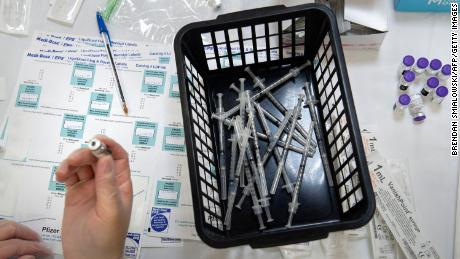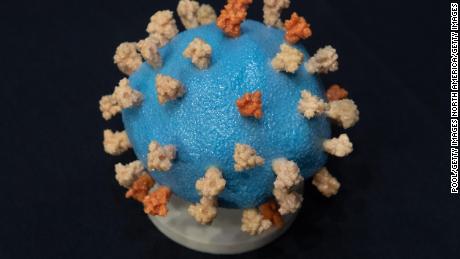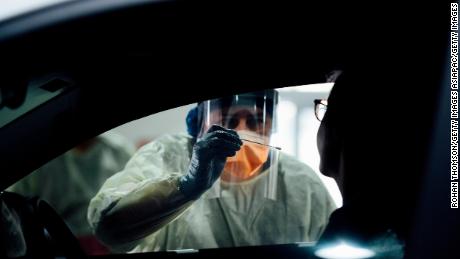It turns out the first two weeks have been abysmal.
The United States just shattered its all-time records for the most Covid-19 infections, hospitalizations and deaths reported in one day:
— On January 2, a record-high 302,506 new infections were reported in one day, according to Johns Hopkins University.
That’s an average of 3.5 people getting infected every second.
— On January 6, a record-high 132,447 patients were hospitalized with Covid-19, according to the Covid Tracking Project.
Many hospitals are now filled beyond capacity, meaning even those without Covid-19 — say, car accident victims — might not get immediate care.
— On January 12, a record-high 4,462 Covid-19 deaths were reported in just one day, according to Johns Hopkins.
about 400 passengers. That means in one day, US deaths from Covid-19 were on par with 11 jumbo jets crashing, killing everyone on board.
Why is this happening?
pandemic fatigue. And many of those who are sick of taking precautions are getting sick.
talks, coughs, sings or even breathes.
linger in the air for minutes to hours,” the US Centers for Disease Control and Prevention said.
able to infect people who are further than 6 feet away from the person who is infected or after that person has left the space,” the CDC said.
bubble — even just one friend — is risky. Gathering with multiple friends indoors can be dangerous.
“If you go to a party with five or more people, almost certainly there’s going to be somebody with Covid-19 at that party,” said Dr. Peter Hotez, dean of the National School of Tropical Medicine at Baylor College of Medicine.
One reason why the coronavirus spreads so easily is because people can be contagious without knowing they’re infected — and can pass along the virus without looking or feeling sick.
50% of all infections are transmitted from people who aren’t showing symptoms.
“This means at least half of new infections come from people likely unaware they are infectious to others,” the agency said.
new waves of infections, hospitalizations and deaths across the country.
Fallout from the holidays could still ripple across the United States for weeks to come.
“It takes two to three weeks for patients to get sick enough to need the hospital after they’ve gotten the virus,” said Dr. Anish Mahajan, chief medical officer at the Harbor-UCLA Medical Center.
Even though Christmas was less than three weeks ago, “we’re already full.”
“We don’t have any more ICU capacity,” Mahajan said. “All of the hospitals in the region are putting ICU patients in unusual places in the hospital just to find room for them.”
Then there are newly identified variants
a highly transmissible variant of the coronavirus that was first detected in the United Kingdom.
Those US cases were found in 12 states: California, Florida, Minnesota, New York, Colorado, Connecticut, Maryland, Texas, Pennsylvania, Indiana, Wisconsin and Georgia, according to CDC data posted Wednesday.
the United States lags behind dozens of other countries in the proportion of Covid-19 cases that are analyzed through genetic sequencing.
United States ranks 61st in how quickly virus samples are collected from patients, analyzed and then posted to an international database to find new variants.
double the number of samples it sequences by mid-January — with a target of 6,500 per week.
Understanding the genetic makeup of a virus and how it changes is critical to ensuring vaccines remain effective.
All viruses mutate over time, and new variants are common.
up to 70% more effective at spreading than others.
While it may be more transmissible, there’s no evidence this variant first detected in the UK is deadlier or causes more severe disease, the CDC said.
But the strain first detected in the United Kingdom isn’t the only one causing concern.
first detected in South Africa has been shown it might be able to escape some of the antibodies produced by a Covid-19 vaccine.
That strain was first spotted two months ago in South Africa and has been found in 12 countries. As of Thursday, it has not been detected in the United States.
Why can’t we all get vaccinated soon?
more slowly than expected.
to vaccinate 20 million people by the end of 2020.
Not even close.
As of Thursday morning, about 10.2 million vaccine doses had been administered, out of roughly 29.3 million doses that have been distributed across the United States, according to the CDC.
And the two vaccines distributed in the United States right now — from Pfizer/BioNTech and Moderna — require two doses for each person.
intended to help guarantee second doses — so more people can get their first dose faster.
Johnson & Johnson and
AstraZeneca.
But either way, millions of Americans will have to wait months before getting a vaccine.
What all this means for you
If you want to get life closer to normal (and more quickly), it’s time to double down on safety measures:
wear a mask at home, too.
Keep social distancing. Wash your hands frequently. And don’t think you’re invincible — even if you’re young and healthy.
severe illness among healthy, young adults with no apparent underlying causes,” Hotez said.
“Whether that’s due to … a higher dose of the virus, whether they have genetic alterations they don’t know about — we just don’t understand,” he said.
“So, we can’t reliably predict who’s going to handle this virus well, and who doesn’t.”
CNN’s Elizabeth Cohen, Maggie Fox, Michael Nedelman and Amanda Watts contributed to this report.













